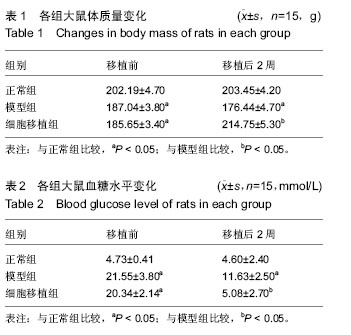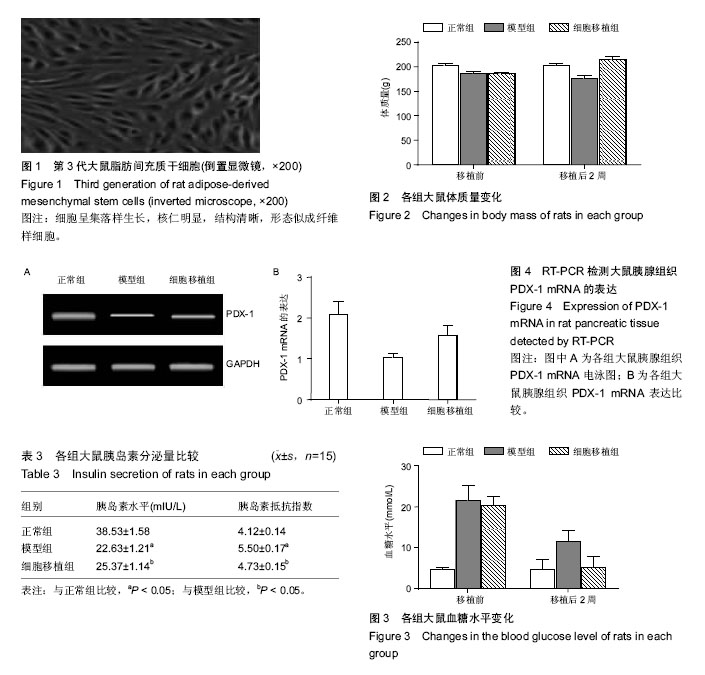| [1] 庄前玲,郭桂芳,李湘萍.糖尿病前期的临床研究进展[J].中华护理杂志,2011,46(8):832-833.
[2] 崔春萍.中华医学会糖尿病学分会,中国2型糖尿病防治指南(2013)[J].中国糖尿病杂志,2014,22(8):32-42.
[3] Antonelli A, Ferrari SM, Giuggioli D, et al. Hepatitis C virus infection and type 1 and type 2 diabetes mellitus.World J Diabetes. 20145;5(5):586-600.
[4] 毛佳,杨涛.1型糖尿病发病机制的研究进展[J].江苏医药, 2013,39(3):342-344.
[5] 迟毓婧,李晶,管又飞,等.1型糖尿病治疗方法的回顾与展望[J].生理科学进展,2010,41(1):55-58.
[6] Lindenmair A, Hatlapatka T, Kollwig G, et al. Mesenchymal stem or stromal cells from amnion and umbilical cord tissue and their potential for clinical applications. Cells. 2012;1(4):1061-1088.
[7] 胡泽斌,王立生,崔春萍,等.干细胞临床应用安全性评估报告[J].中国医药生物技术,2013,8(5):349-361.
[8] Amable PR, Teixeira MV, Carias RB, et al. Protein synthesis and secretion in human mesenchymal cells derived from bone marrow, adipose tissue and Wharton's jelly. Stem Cell Res Ther. 2014;5(2):53.
[9] de Girolamo L, Lucarelli E, Alessandri G, et al. Mesenchymal stem/stromal cells: a new ''cells as drugs'' paradigm. Efficacy and critical aspects in cell therapy. Curr Pharm Des. 2013;19(13):2459-2473.
[10] Ma S, Xie N, Li W, et al. Immunobiology of mesenchymal stem cells. Cell Death Differ. 2014;21(2): 216-225.
[11] Cuiffo BG, Karnoub AE. Mesenchymal stem cells in tumor development: emerging roles and concepts. Cell Adh Migr. 2012;6(3):220-230.
[12] Seino Y, Nanjo K, Tajima N, et al. Report of the committee on the classification and diagnostic criteria of diabetes mellitus. J Diabetes Investig. 2010;1(5): 212-228.
[13] American Diabetes Association. Standards of medical care in diabetes--2013. Diabetes Care. 2013;36 Suppl 1:S11-66.
[14] American Diabetes Association. Diagnosis and classification of diabetes mellitus.Diabetes Care. 2013; 36 Suppl 1:S67-74.
[15] Qiu YH, Deng FY, Li MJ, et al. Identification of novel risk genes associated with type 1 diabetes mellitus using a genome-wide gene-based association analysis. J Diabetes Investig. 2014;5(6):649-656.
[16] 陶桂香,徐洋.1型糖尿病发病机制及治疗研究[J].中国免疫学杂志,2015,31(10):1297-1303.
[17] ?urawska-Kli? M, Lesman J, Pietrzak I, et al. The impact of having siblings - analysis of "hygiene theory" of chronic diseases in patients with type 1 diabetes in population of the ?ódz region Hygiene theory and type 1 diabetes. Pediatr Endocrinol Diabetes Metab. 2015; 20(3):95-100.
[18] de Girolamo L, Lucarelli E, Alessandri G, et al. Mesenchymal stem/stromal cells: a new ''cells as drugs'' paradigm. Efficacy and critical aspects in cell therapy. Curr Pharm Des. 2013;19(13):2459-2473.
[19] Bieback K, Brinkmann I. Mesenchymal stromal cells from human perinatal tissues: From biology to cell therapy. World J Stem Cells. 2010;2(4):81-92.
[20] Kim N, Cho SG. Clinical applications of mesenchymal stem cells. Korean J Intern Med. 2013;28(4):387-402.
[21] 李建鑫,杨亮,王文良.脂肪间充质干细胞在组织工程中的应用[J].中国组织工程研究与临床康复,2010,14(7): 1274-1277.
[22] 殷莉波,赵文秀,尹震宇,等.人脂肪间充质干细胞的分离培养及其鉴定[J].中国组织工程研究与临床康复,2010, 14(32):5997-6000.
[23] Al-Nbaheen M, Vishnubalaji R, Ali D, et al. Human stromal (mesenchymal) stem cells from bone marrow, adipose tissue and skin exhibit differences in molecular phenotype and differentiation potential. Stem Cell Rev. 2013;9(1):32-43.
[24] van Dijk PR, Logtenberg SJ, Hendriks SH, et al. Intraperitoneal versus subcutaneous insulin therapy in the treatment of type 1 diabetes mellitus. Neth J Med. 2015;73(9):399-409.
[25] Sena CM, Bento CF, Pereira P, et al. Diabetes mellitus: new challenges and innovative therapies. EPMA J. 2010;1(1):138-163.
[26] Ramirez L, Hamad AR. From non-obese diabetic to Network for the Pancreatic Organ Donor with Diabetes: New heights in type 1 diabetes research. World J Diabetes. 2015;6(16):1309-1311.
[27] Holditch SJ, Terzic A, Ikeda Y. Concise review: pluripotent stem cell-based regenerative applications for failing β-cell function. Stem Cells Transl Med. 2014;3(5):653-661.
[28] Minami K, Doi R, Kawaguchi Y, et al. In vitro generation of insulin-secreting cells from human pancreatic exocrine cells. J Diabetes Investig. 2011; 2(4):271-275.
[29] Shimoda M, Chen S, Noguchi H, et al. A new method for generating insulin-secreting cells from human pancreatic epithelial cells after islet isolation transformed by NeuroD1. Hum Gene Ther Methods. 2014;25(3):206-219.
[30] Hecking M, Werzowa J, Haidinger M, et al. Novel views on new-onset diabetes after transplantation: development, prevention and treatment. Nephrol Dial Transplant. 2013;28(3):550-566.
[31] O'Sullivan ES, Vegas A, Anderson DG, et al. Islets transplanted in immunoisolation devices: a review of the progress and the challenges that remain. Endocr Rev. 2011;32(6):827-844.
[32] Guo T, Hebrok M. Stem cells to pancreatic beta-cells: new sources for diabetes cell therapy. Endocr Rev. 2009;30(3):214-227.
[33] Sordi V, Piemonti L. Mesenchymal stem cells as feeder cells for pancreatic islet transplants. Rev Diabet Stud. 2010;7(2):132-143.
[34] 陈海鸥,胡小宣,刘洪娟,等.脐血干细胞移植治疗肝硬化的疗效观察[J].肝脏,2010,15(2):81-83.
[35] Fiorina P, Voltarelli J, Zavazava N. Immunological applications of stem cells in type 1 diabetes. Endocr Rev. 2011;32(6):725-754.
[36] Chhabra P, Brayman KL. Stem cell therapy to cure type 1 diabetes: from hype to hope. Stem Cells Transl Med. 2013;2(5):328-336.
[37] Bruni A, Gala-Lopez B, Pepper AR, et al. Islet cell transplantation for the treatment of type 1 diabetes: recent advances and future challenges. Diabetes Metab Syndr Obes. 2014;7:211-223.
[38] 楚元奎,曹晖,王赟,等.胎猪胰腺干细胞体外诱导分化为胰岛素分泌细胞及其移植治疗裸鼠糖尿病的研究[J].农业生物技术学报,2011,19(1):9-17.
[39] 陈国昌,王熙然.干细胞移植治疗糖尿病的国内外研究趋势分析[J].中国组织工程研究,2012,16(36):6834-3840.
[40] 王广宇,朱旅云,马利成,等.干细胞移植治疗糖尿病足[J].中国组织工程研究,2013,17(1):173-180. |
.jpg)


.jpg)